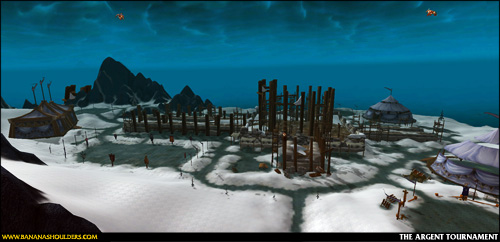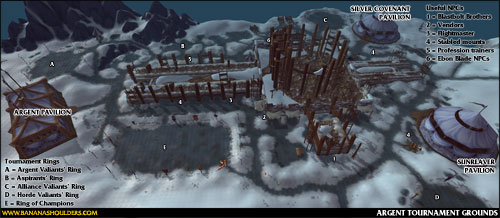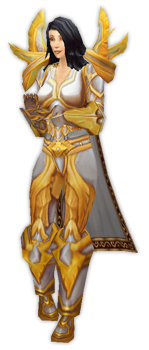Patch 3.1 brought the Argent Tournament, a new world event featuring mounted combat, new daily quests, new mounts, pets, tabards, and new and interesting ways to get reputation. Read on for a guide to the Argent Tournament!
Note that this is a couple of months late, by now! However, I know there are some folks out there who still haven’t started the Argent Tournament and have found the previous parts of my guide handy, plus I’m about to write the fourth part with a guide to the changes in Patch 3.2.
I’ll present this guide in three posts:
- Part I: explains the scenario and the location, the side quests and the Aspirant stage of mounted combat.
- Part II: covers the Valiant stage of the mounted combat event and questing.
- Part III: covers the Champion stage of the questing, and where to go from there.

Phase 5: Becoming a Champion
So! You’ve acquired your 25 Valiant’s Seals and you’re keen to qualify as a Champion of your faction? Read on!
Hand those 15 seals in to your faction’s Grand Champion, who will give you a new quest, The Valiant’s Challenge. This quest asks you to equip your lance, mount up and ride to the Argent Valiant’s Ring (location A on the map below).

When you’re there, speak to Squire Danny; he summons a Champion for you to fight.
This is basically a harder version of the trial to become a Valiant that you successfully completed 25 seals ago. The Champion you’re fighting will use all the same abilities the Valiants use, but he’ll be faster to put his Defense stacks up when you knock them off, he’s more likely to Charge and Shield-Breaker you, and it’s generally got less margin for error. However, it’s easily soloable if you can do the Valiant jousting with no problems, and if you do have difficulties you can get a friend to help you on foot. (Ranged DPS is better than melee, because the Champions run around so much.)
Once you’ve beaten the Argent Champion, return to your faction’s pavilion and hand in. Congratulations, you’re now a Champion! If you have Exalted reputation with your home city, you’ll also get the “Exalted Champion of…” achievement at the same time, and a shiny new title.
Phase 6: The Champion
Now that you’re a champion, you’ve got two paths to follow: doing the Champion-only dailies, and beginning to Champion another city.
In your faction’s tent, the other racial faction leaders will have quests; pick the next faction you wish to champion, and accept their quest. That will make you a valiant of that faction, as well as a champion of your first faction – for instance, if my home faction is Stormwind and I go to the Ironforge leader next, I’ll have access to all the Champion dailies, and the Stormwind vendor, and I’ll also be considered an Ironforge valiant and have access to their dailies.
The Champion dailies are given in the Argent Pavilion in the west of the grounds, and are as follows:
- Taking Battle to the Enemy requires you to kill 15 Scourge in Icecrown, and can be done at the same time as the Valiant daily A Valiant’s Field Training for doubled-up quest credit.
- Battle Before the Citadel is a mounted quest at Corp’rethar, and can be done at the same time as the Valiant daily At the Enemy’s Gates for doubled-up quest credit.
- Threat From Above is a group quest to kill a frost wyrm near Aldur’thar; you can only get this quest after completing Crusader Rhydalla’s questline about the Black Knight.
- Among the Champions is the Champion-level jousting quest.
- Squire Artie in the Argent Pavilion also gives a daily quest to donate 10 gold in exchange for 100 Argent Crusade reputation; obviously this isn’t available to people with Exalted reputation.
Champion dailies pay gold, plus Champion’s Seals (the currency for Argent Tournament rewards), plus a choice of either a Writ or a Purse. The Writs can be turned in at the factional vendors for tokens that increase your racial city reputations; the Purses contain 10g and very occasionally an extra Champion’s Seal.
Threat From Above
This is a fairly straightforward group quest to kill the frostwyrm Chillmaw, who spawns around 43,32 in Icecrown. Throughout the fight Chillmaw spawns three Cultist Bombadiers, who are also required for quest completion.
This quest can be soloed by some classes, particularly those with self-healing abilities and/or pet tanks. However, on reasonably populous servers there’s a constant stream of “LFG TFA!” in Icecrown General chat, so there’s no reason to go it alone unless you’re trying to prove something to yourself.
The ickiest bit of the fight, other than competing with other groups to nab the spawn (which is mostly handled fairly courteously on my server, but not always), is in handling the bombadiers who spawn. They throw bombs on the ground which explode on a time delay, so if you stand in the one spot for too long and don’t watch your surrounds, you easily can be killed by a couple of explosions.
Among the Champions
This is the Champion-level jousting quest; look for the Ring of Champions at point E on the map above.
The Trial to become a champion is a good indication of the increased difficulty of the NPC champions, compared with the NPC valiants. They’re tuned more finely; they put shields up faster, they’re more aggressive, and they’re harder to shake to get Charge distance on. However, they’re still eminently beatable; if you have problems, just stick to the strategy I described in Part II of this guide series for the valiants, and you’ll come out on top (albeit slowly).
Rewards
Once you’re a Champion of one or more factions, you can buy rewards with the Champions Seals you receive from the daily quests (which, unlike the Aspirant and Valiant tokens, can be found on your Currency pane rather than in your bags).
At present, the following are available:
- 5 mini pets, one per faction. 40 Seals each, and unlike all the other rewards, the pets are BoE:
- Darnassus: Teldrassil Sproutling
- Exodar: Ammen Vale Lashling
- Gnomeregan: Mechanopeep
- Ironforge: Dun Morogh Cub
- Stormwind: Elwynn Lamb
- The Horde equivalents are the Sen’jin Fetish, Tirisfal Batling, Enchanted Broom, Durotar Scorpion and Mulgore Hatchling.
- 5 tabards, one per faction. 50 Seals each.
- Ground mounts: 5 “cheap” mounts using old skins and 5 regular mounts using the current jousting mount skins. One cheap mount (5 Seals and 400g each) and one regular mount (100 seals each) per faction (listed as Cheap/Regular):
- Darnassus: Swift Moonsaber/Darnassian Nightsaber
- Exodar: Great Red Elekk/Exodar Elekk
- Gnomeregan: Turbostrider/Gnomeregan Mechanostrider
- Ironforge: Swift Violet Ram/Ironforge Ram
- Stormwind: Swift Gray Steed/Stormwind Steed
- The Horde equivalents are the Swift Purple Raptor/Darkspear Raptor, White Skeletal Warhorse/Forsaken Warhorse, Swift Red Hawkstrider/Silvermoon Hawkstrider, Swift Burgundy Wolf/Orgrimmar Wolf and Great Golden Kodo/Thunder Bluff Kodo.
- 1 flying mount, available to Alliance and Horde: the Argent Hippogryph, for 150 Seals.
- 5 banners, one per faction. 15 Seals each. Banners have no purpose other than to be placeable decorative items.
- Epic weapons costing 25 Seals each, and Rare armor pieces costing 15 seals each. (These are all accessible as soon as you reach Champion with your first faction, although they have racial-specific names.)
 There are plenty of guides around – my own, and other people’s – that tell you what gear goals you should set, how you should gem, what consumables you should use. The big problem with most of these guides is that they don’t tell you why. They don’t make the relationships between healer stats clear, so people wind up following a set of rules they don’t understand.
There are plenty of guides around – my own, and other people’s – that tell you what gear goals you should set, how you should gem, what consumables you should use. The big problem with most of these guides is that they don’t tell you why. They don’t make the relationships between healer stats clear, so people wind up following a set of rules they don’t understand.